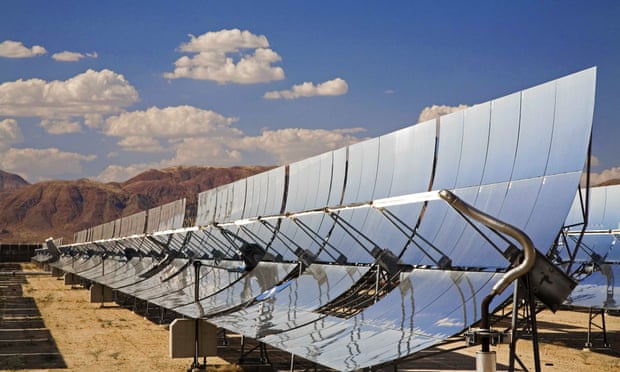Thursday, July 28, 2016 12:40:48 PM
The transition to solar is happening faster than predicted, and now power can be stored when the sun isn’t shining. This book is a guide to the latest exciting developments
https://www.theguardian.com/books/2016/jul/28/the-switch-chris-goodall-review-solar-power-taking-over

A solar electricity generating in the Mojave desert, California. Photograph: Sipa Press / Rex Features
A sense of drift and apathy has pervaded the global warming and renewable energy debate for too long. The fossil fuel companies continue to dig coal and pump oil and gas; herbivorous idealists, scientists and ecowarriors emit their ritual opposition. The carbon load forced into the atmosphere continues to rise, and the general public seems resigned.
But 2016 is the year this will really begin to change. Chris Goodall’s book is wonderfully up to date but, thanks to the pace of change, even he couldn’t keep up with the avalanche of news and initiatives conspiring to justify his subtitle. In May, Shell announced a major move into renewables; on 15 May Germany received almost all its electricity from renewables; for four days from 7 to 10 May Portugal did the same. Goodall, who is an economist rather than a technologist or ecowarrior, explains why the change is happening now: the cost of solar electricity is falling much faster than anyone predicted. Solar power is approaching parity with fossil fuels and can only become cheaper as time goes by.
Sunny Portugal might run fossil-free for four days but what happens when the sun doesn’t shine and the wind refuses to blow? The recent Ren21 global status report, while reporting that clean energy investment in 2015 ($286bn, or £217bn) was more than double that for fossil fuels ($130bn, or £99bn), added the rider: “But the fast-maturing renewables sector still has to overcome storage limitations and the world’s dependence on infrastructure systems geared towards fossil fuels.” In the latter part of the book Goodall addresses this, explaining the missing factor – the final piece of the puzzle.
Goodall writes that the sun supplies enough power in 90 minutes to meet the world’s total energy needs for a year. When solar and wind installations reach a certain critical level, there will be periods when they produce far more energy than can be used. Electricity cannot itself be stored but that surplus electricity and indeed sunlight itself can be used to create liquid hydrocarbons for fuel, plastics and other chemicals and methane to drive gas-fired power stations at times when renewable output dips. This is not a pipe dream. An exciting project, launched as the Global Apollo programme in 2015 and taken up, thanks to Bill Gates’ ministrations, by 20 major governments at the Paris climate conference in December 2015, is to produce liquid fuels and methane directly from carbon dioxide using sunlight – in effect, mimicking the photosynthesis that every plant accomplishes so easily.
Advertisement
David Attenborough, one of the founders of the Global Apollo programme, has said: “If we could put a man on the moon in 10 years you mean to say we can’t solve the problem of getting one 500th part of the energy from the sun? It’s really a tiny technological problem.” It isn’t quite such a tiny problem, but lab scientists such as Peidong Yang at Berkeley and commercial companies such as LanzaTech in the US and Carbon Recycling International in Iceland are already showing the way.
The surplus solar energy of summer will be squirrelled away into liquid fuel and gas for winter, rather as the sun’s past bounty produced the surplus we now consume as fossil fuels. And this project has the backing of scientists, technologists, economists, governments, great foundations, major investors and even giant energy companies from the fossil era (because the liquid fuels and gas will use the existing infrastructure: a huge economic boon).
The “switch” is coming. It will probably take 20 years to make a major impact, but we should see the first fruits very soon. This book is the essential guide to this great benign change, although I could have done with some sense of the grandeur of what we are on the verge of achieving. For 4.5bn years, light has been pouring down on the earth, creating and sustaining the cornucopia of life. For two and a half centuries we have been living off hundreds of millions of years of stored sunlight. And for over half a century, scientists have been working to unlock the secrets of plant photosynthesis. This is now known down to the last atom, and this achievement should rank with Watson and Crick’s elucidation of the DNA structure. It’s time to put that knowledge to work for us.
VHAI - Vocodia Partners with Leading Political Super PACs to Revolutionize Fundraising Efforts • VHAI • Sep 19, 2024 11:48 AM
Dear Cashmere Group Holding Co. AKA Swifty Global Signs Binding Letter of Intent to be Acquired by Signing Day Sports • DRCR • Sep 19, 2024 10:26 AM
HealthLynked Launches Virtual Urgent Care Through Partnership with Lyric Health. • HLYK • Sep 19, 2024 8:00 AM
Element79 Gold Corp. Appoints Kevin Arias as Advisor to the Board of Directors, Strengthening Strategic Leadership • ELMGF • Sep 18, 2024 10:29 AM
Mawson Finland Limited Further Expands the Known Mineralized Zones at Rajapalot: Palokas step-out drills 7 metres @ 9.1 g/t gold & 706 ppm cobalt • MFL • Sep 17, 2024 9:02 AM
PickleJar Announces Integration With OptCulture to Deliver Holistic Fan Experiences at Venue Point of Sale • PKLE • Sep 17, 2024 8:00 AM






